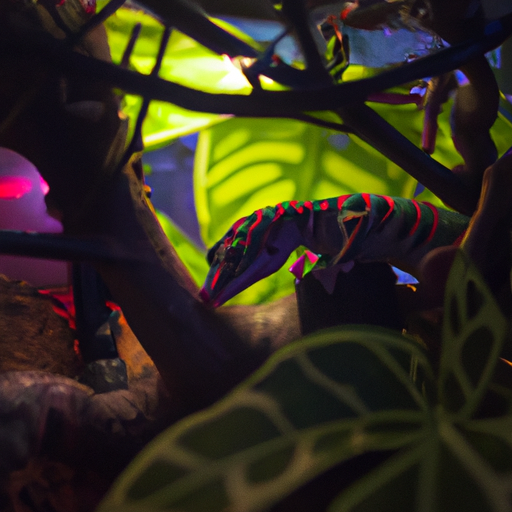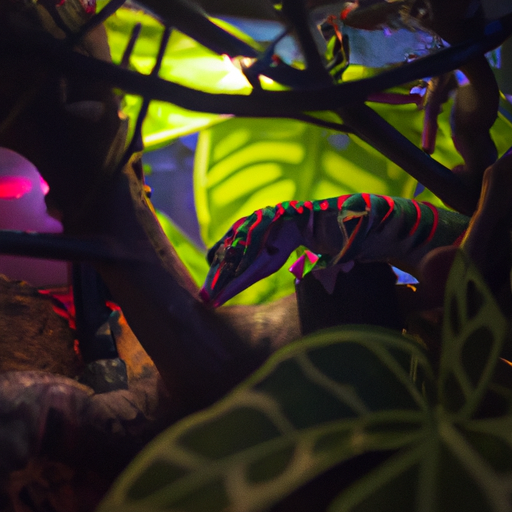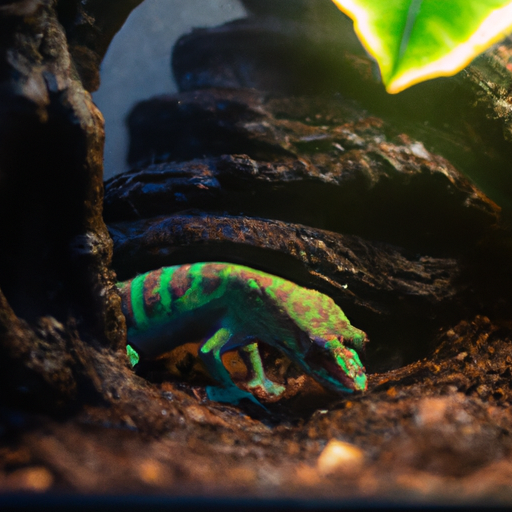
Geckos, fascinating reptilian creatures known for their unique features, have long been a popular choice for pet enthusiasts. However, when it comes to providing the optimal living conditions for these creatures, one question often arises: do geckos need a heat lamp? In this article, we will explore the importance of heat lamps for geckos, shedding light on their heat requirements and the potential benefits they offer in maintaining their health and well-being. So, if you have ever wondered about the necessity of a heat lamp for your gecko, read on to discover the answer and gain valuable insights into the world of these captivating creatures.
Introduction
Geckos are unique and fascinating reptiles that require specific environmental conditions to thrive. One crucial aspect of their care is providing the appropriate heat source. Heat lamps are a popular choice among gecko owners, as they can fulfill both the temperature and lighting needs of these reptiles. In this article, we will discuss the basic requirements of geckos, explore the advantages and disadvantages of using heat lamps, and ultimately help you choose the right heat lamp for your gecko.
Basic Requirements of Geckos
Temperature
Maintaining the correct temperature is crucial for the overall health and well-being of geckos. Different gecko species have varying temperature requirements, but a general range of 75 to 90 degrees Fahrenheit during the day and a slight drop to around 70 to 80 degrees Fahrenheit at night is suitable for most species. Providing a temperature gradient within the enclosure allows geckos to regulate their body temperature by moving to areas that suit their needs.
Lighting
Proper lighting is essential for geckos, as it helps regulate their circadian rhythm and provides opportunities for natural behaviors like basking and hunting. While geckos do not require UVB lighting, they do benefit from exposure to low levels of UVA light. This can be achieved through the use of full-spectrum light sources or by providing appropriate ambient lighting in the room where the gecko enclosure is located.
Humidity
Geckos come from a variety of habitats, ranging from arid deserts to humid rainforests. It is crucial to research the specific humidity requirements of your gecko species to ensure their health. For example, desert-dwelling geckos may require lower humidity levels, while rainforest species may need higher humidity. Providing a suitable humidity level through misting, the use of a humidifier, or proper substrate is essential for their overall well-being.
Habitat Setup
Creating a suitable habitat for your gecko is essential for their overall health. An ideal gecko enclosure should include hiding spots, climbing areas, and a suitable substrate such as reptile carpet or specialized substrates designed for geckos. Avoid using substrates that may cause impaction, such as loose sand or small particles that geckos can accidentally ingest. Additionally, include appropriate decor and branches for geckos to climb on, creating a stimulating and enriching environment.

Heat Sources for Geckos
Heat Lamps
Heat lamps provide a combination of heat and light, making them a popular choice for gecko owners. They are available in various types, including incandescent bulbs, halogen bulbs, mercury vapor bulbs, and ceramic heat emitters. Heat lamps offer distinct advantages, such as precise temperature control, fulfilling the lighting needs of geckos, and emulation of natural sunlight.
Under Tank Heaters
Under tank heaters, also known as belly heat pads, are another commonly used heat source for gecko enclosures. Unlike heat lamps, which emit heat from above, under tank heaters adhere to the underside of the terrarium and radiate heat upwards. They provide a constant source of heat and are particularly useful for mimicking natural ground heat for nocturnal gecko species. However, under tank heaters should be used in conjunction with other heat sources to ensure proper temperature gradients within the enclosure.
Ceramic Heat Emitters
Ceramic heat emitters are heat lamps that are solely designed to provide heat without emitting light. They are particularly useful for maintaining nighttime temperatures without disrupting the gecko’s sleep cycle. Ceramic heat emitters generate infrared heat, which can penetrate the enclosure to create a suitable warmth. They are ideal for use in combination with other lighting sources, such as UVB or ambient room lighting.
Heat Mats
Heat mats, also known as heat pads or heat tape, are another option for providing targeted warmth to specific areas of the gecko enclosure. They are typically placed underneath one-third of the tank to create a temperature gradient. Heat mats are most commonly used in conjunction with other heat sources like heat lamps or ceramic heat emitters to ensure optimal heat distribution within the tank.
Advantages of Heat Lamps
Temperature Control
One of the significant advantages of using heat lamps is the precise control over temperature they offer. With the use of a thermostat or rheostat, you can easily regulate the heat output to maintain the ideal temperature range for your geckos. This level of control is particularly important for achieving the proper temperature gradient within the enclosure, allowing the geckos to thermoregulate effectively.
Lighting Needs
Geckos require light exposure to regulate their circadian rhythm and engage in natural behaviors. Heat lamps that emit both heat and light fulfill this requirement, providing a convenient solution for gecko owners. By selecting appropriate bulbs, you can ensure that your geckos receive the necessary lighting without the need for additional light sources.
Emulation of Natural Sunlight
Heat lamps attempt to replicate the natural sunlight that geckos would experience in their native habitats. This emulation of sunlight ensures that the geckos receive appropriate levels of UVA light, which plays a role in their overall health and well-being. Furthermore, providing a light source that mimics natural sunlight can help stimulate natural behaviors and promote a more naturalistic environment for your geckos.

Disadvantages of Heat Lamps
Higher Energy Consumption
One of the downsides of using heat lamps is their higher energy consumption compared to some other heat sources. Heat lamps require electricity to operate and can contribute to an increase in your energy bill. However, with proper energy-efficient choices and careful usage, this disadvantage can be minimized.
Possible Burn Risks
Heat lamps, particularly those that emit intense heat, can pose a burn risk to geckos if not appropriately installed or if geckos come into direct contact with them. It is essential to monitor the temperature and ensure that the geckos cannot access the heat lamp itself. By providing adequate distance and utilizing protective screens or guards, the risk of burns can be significantly reduced.
Light Disturbances
For gecko species that require a specific photoperiod, the use of heat lamps can cause disturbances in their natural light-dark cycle. Geckos may become stressed or confused if there are sudden changes in lighting levels or if artificial light is present during their usual sleep period. It is crucial to consider the specific lighting requirements of your gecko species when choosing a heat lamp to minimize any potential disruptions.
Types of Heat Lamps
Incandescent Bulbs
Incandescent bulbs are a common type of heat lamp used in gecko enclosures. They emit both heat and light, making them suitable for geckos that require both temperature control and lighting. Incandescent bulbs come in various wattages, allowing the owner to select the appropriate power based on the needs of the geckos and the size of the enclosure.
Halogen Bulbs
Similar to incandescent bulbs, halogen bulbs emit both heat and light. However, they are more energy-efficient and have a longer lifespan. Halogen bulbs also produce a brighter and whiter light compared to incandescent bulbs, which may be beneficial for simulating natural daylight in the gecko enclosure.
Mercury Vapor Bulbs
Mercury vapor bulbs are a type of self-ballasted bulb that provides both heat and UVB lighting. They are an excellent option for geckos that have higher UVB requirements, as these bulbs can emit higher levels of UVB. However, it is crucial to monitor the distance between the geckos and the bulb to prevent potential UVB overexposure.
Ceramic Heat Emitters
Ceramic heat emitters solely emit heat and do not produce light. They are suitable for geckos that require nighttime heating or for use in conjunction with other light sources. Ceramic heat emitters are particularly useful for nocturnal gecko species, as they do not disrupt their natural sleep cycles.
Choosing the Right Heat Lamp
Gecko Species Requirements
Different gecko species have varying temperature and lighting requirements. It is crucial to research the specific needs of your gecko species before selecting a heat lamp. Some species may require higher temperatures, while others may thrive at lower temperatures. Additionally, certain species may have unique UVB or UVA requirements, which can influence the choice of heat lamp.
Tank Size and Setup
The size of your gecko’s enclosure and the overall habitat setup should also be considered when choosing a heat lamp. Larger enclosures may require multiple heat lamps or a combination of heat sources to maintain proper temperature gradients. Similarly, the availability of suitable perches, basking spots, and hiding areas should be taken into account to ensure the proper placement of the heat lamp.
Energy Efficiency
Given the potential for higher energy consumption with heat lamps, it is wise to consider energy-efficient options. Look for heat lamps that are labeled as energy-efficient or low-wattage alternatives. Additionally, utilizing thermostats or timers can help regulate the heat output and minimize energy wastage.
Proper Placement of Heat Lamps
Temperature Gradient
Creating a temperature gradient is essential for geckos, as it allows them to move between warmer and cooler areas as needed. Place the heat lamp at one end of the enclosure to create a warmer basking spot, while the opposite end should provide a cooler retreat. This temperature gradient allows geckos to regulate their body temperature and thermoregulate effectively.
Creating Basking Spots
Geckos, like many reptiles, require basking spots to raise their body temperature. Position the heat lamp in a way that creates a warm basking spot underneath it. This can be achieved by using branches, rocks, or other elevated platforms where the geckos can climb and bask under the heat lamp.
Avoiding Overheating
It is crucial to monitor the temperature within the gecko enclosure to prevent overheating. Use a reliable thermometer to regularly check the temperatures at various points within the habitat. Adjust the wattage of the heat lamp or the distance between the lamp and the enclosure as necessary to maintain the desired temperature range.
Alternatives to Heat Lamps
Under Tank Heaters
Under tank heaters provide a consistent source of heat from below, mimicking the natural ground heat that geckos would experience in their native habitats. They are particularly useful for gecko species that require specific belly heat for digestion or nocturnal species that do not rely heavily on basking under a heat lamp. Combining under tank heaters with other heat sources like ceramic heat emitters or heat mats can help create a suitable temperature gradient within the enclosure.
Ceramic Heat Emitters
Ceramic heat emitters solely emit heat without any light, making them an ideal option for gecko species that require nighttime heating or for use in conjunction with other lighting sources. They have the advantage of not disrupting the gecko’s sleep cycle while still providing warmth that is essential for their overall health.
Heat Mats
Heat mats, when used in combination with other heat sources, can provide targeted warmth to specific areas of the gecko enclosure. They are particularly useful for creating a temperature gradient or localized heat for specific gecko behaviors. Heat mats can be placed underneath a portion of the tank or affixed to the side to help maintain optimal temperatures.
Conclusion
Choosing the right heat source for your gecko is vital for their overall health, as it helps meet their temperature and lighting requirements. Heat lamps, with their ability to provide controlled temperature and lighting, are a preferred choice for many gecko owners. However, it is essential to consider the specific needs of your gecko species, the size and setup of the tank, and energy efficiency when selecting a heat lamp. Proper placement and monitoring of temperatures within the enclosure are crucial to ensure the well-being of your gecko. Additionally, alternative heat sources like under tank heaters, ceramic heat emitters, and heat mats can be used in combination with or as alternatives to heat lamps for specific gecko species and setups. By understanding the basic requirements and available options, you can provide the optimal heat source for your gecko’s health and happiness.